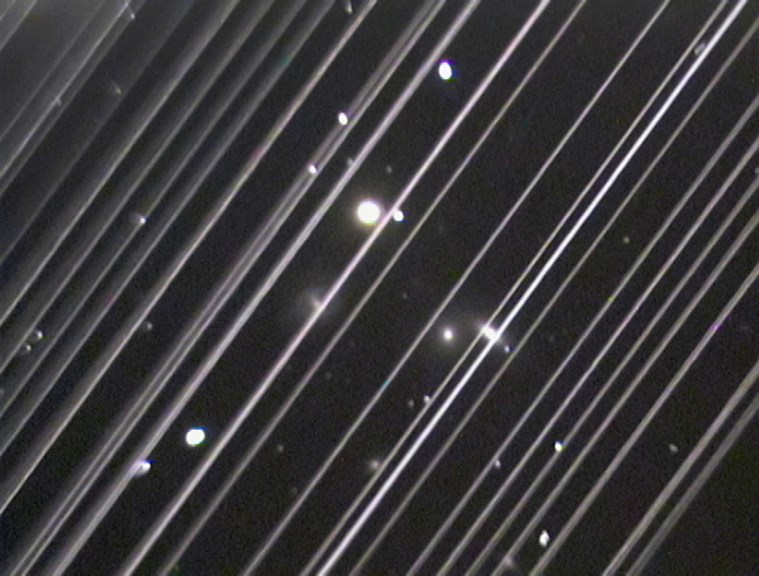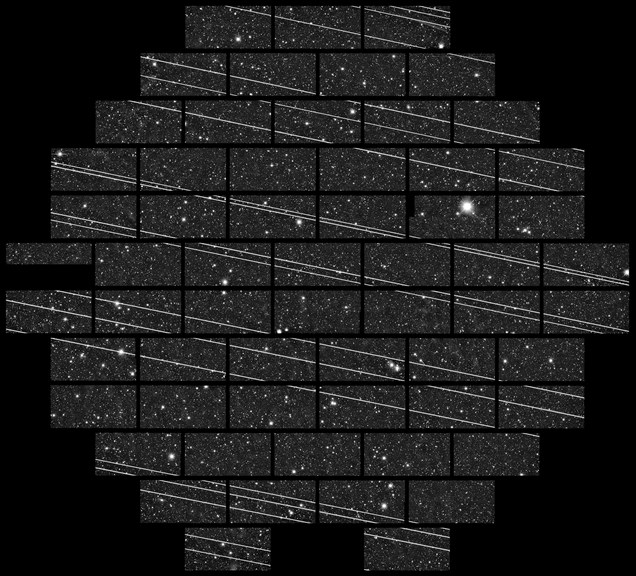Skynotes: April 2020
Satellites – we need them, but problems are coming
It’s not only local light pollution that interferes with our enjoyment of the night sky. Amateur and professional astronomers are deeply concerned by launches into low earth orbit (LEO) of large numbers of new satellites – so called ‘megaconstellations’. Space X’s Starlink project is one with OneWeb and Amazon also in the game.
Already this is a crowded region full of busy satellites in equatorial, mid-latitude and polar orbits all serving a range of purposes; Earth resources studies, military surveillance, mobile phone coverage, geospatial location and time signalling, to name just a few types.
A growing concern for Earth-based telescopes, and the cutting-edge research they support or generate, is the proliferation of fleets of new generations of communications satellites. All satellites unavoidably reflect sunlight for part of their orbit, and to varying degrees depending on their orientation, altitude, orbital parameters, size and surface reflectivity. The danger for astronomy is that there are so many and they are so bright. Whilst optical astronomy would seem to suffer the most, even radio and millimetre wavelength astronomy may not be immune.
Another pressing and related issue, and getting worse all the time, is the increasing problem of space junk in the form of failed, discarded or decommissioned satellites, spent rocket casings, satellite adaptors, launch detritus, and collision debris. It is estimated over 34,000 objects larger than 10cm lie in Earth orbit, including 5500 satellites of which only 2300 are operationally active.
There are many uncertainties and modelling of potential effects is being done, but thousands of new satellites in LEO would surely compound existing problems, complicate risk assessments, impact insurance cover, and increase the likelihood of orbital collisions.
Find out more
Planetarium
While the Melbourne Planetarium and all Museums Victoria venues are closed, our websites are full of interesting content. Explore our astronomy factsheets and education pages as we continue to add exciting new material for our web visitors to learn from and enjoy.
Melbourne sun times**
| Date | Rise / Solar noon* / Set (day length) |
|---|---|
| Wed 1st | 7.34am / 1.23pm / 7.13pm (11.39 hrs) |
| Sat 11th | 6.43am / 12.21pm / 5.58pm (11.15 hrs) |
| Tue 21st | 6.52am / 12.18pm / 5.45pm (10.52 hrs) |
| Thu 30th | 7.00am / 12.17pm / 5.33pm (10.33 hrs) |
**Daylight Savings Time ends 3am, Sunday 5 April.
*When the Sun is at its highest crossing the meridian or local longitude.
Moon phases
| Phase | Date |
|---|---|
| First Quarter | Wed 1st |
| Full Moon | Wed 8th |
| Third Quarter | Wed 15th |
| New Moon | Thu 23rd |
This month’s Moon perigee (closest to Earth) is on Wed 8th at 356,906 km and apogee (furthest from Earth) is on Tue 21st at 406,692 km.
Planets
Mercury, the fastest moving planet closest to the sun, will rise about two hours before sunrise and remain visible until the 7th.
Venus is again the ‘evening star’ very close in the north-west to the Pleiades cluster, and reaching maximum magnitude by the 27th.
Mars rises just after midnight shortly before yellowish Saturn.
Jupiter rises just before midnight and should be easily visible as the third brightest object in the night sky after the moon and Venus.
Saturn follows Jupiter rising about half an hour later. Mars will lie near Saturn allowing a close comparison with the Red Planet.
Meteors
April’s main shower, The Lyrids, is centred near the bright star Vega low in the north at 3am. It is active from 16th–25th peaking on the 22nd. Better placed is the Pi-Puppids associated with Comet Grigg-Skjellerup which peaks on 24th centred low in the south-west near Canopus in Carina. Also the delta Pavonids from March peak on the 6th centred on the constellation of Pavo which lies near the South Celestial Pole.
Stars and constellations
The Southern Cross can be found high in the south-east with the Two Pointers trailing behind. To the right of the Cross, in the south-western sky, is the star Canopus, the second brightest star in the night sky. Low in the south is Achernar, the head of the river Eridanus. Achernar never sets in Melbourne and is called a circumpolar star, along with the Southern Cross and the Two Pointers (Alpha and Beta Centauri). The Cross is also Bunya the possum from the Boorong tradition of north-west Victoria with its 5th brightest star, Epsilon Crucis, now named Ginan. To find out more about our First Nations’ night sky and current research go to:
Orion, the hunter, is in the west and Scorpius too for a brief time after sunset in the east. Orion is lying on his side low in the west with the red star Betelgeuse as one of his shoulders, and higher up is Sirius, the brightest star in the night sky. Close to the western horizon is the triangular head of Taurus, the bull, with the red star Aldebaran. Scorpius can be found rising in the east with the red star Antares marking the Scorpion’s heart. That’s three red giant stars easily visible at the same time this month.
In dark locations, the Milky Way can be seen stretching from south-east to north-west, with the dark regions an emu from indigenous astronomy. The Coal Sack beside the Southern Cross is the emu’s head and its body the dark areas extending down to Scorpius.
International Space Station
ISS orbits every 90 minutes at an average distance of 400 km appearing like a bright star moving slowly across the night sky. Here are some of the brightest passes expected this month over Melbourne and Central Victoria:
Monday 13th 5:07am-5:10am, South-South-East to North-East.
Tuesday 21st 6:38pm-6:44pm, North-West to South-East.
Monday 20th 7:26pm-7:29pm, West-North- West to South-South-West.
For predictions go to:
On this day
1st 1948, Alpha, Bethe and Gamow publish their famous paper on the ‘hot Big Bang’.
2nd 1845, Fizeau and Foucault take the first photograph of the Sun.
3rd 1966, Luna 10 (USSR) became the first spacecraft to orbit the Moon.
4th 1979, Voyager 1 (USA) discovered the rings of Jupiter.
6th 1973, Pioneer 11 (USA) probe launched to Jupiter and Saturn.
8th 1732, birth of David Rittenhouse who determined Earth-Sun distance of 150 million km.
9th 1959, NASA’s first cohort of astronauts, “the Mercury 7”, are announced.
11th 1905, Einstein’s ‘Special Theory of Relativity’ is published.
11th 1970, Apollo13 (USA) was launched on its ill-fated mission.
12th 1633, Galileo’s trial by the Catholic Inquisition, on the question of a sun-centred solar system, begins in Rome.
12th 1961, Yuri Gagarin (USSR) became the first human in space orbiting Earth for 108 minutes in Vostok 1.
12th 1981, Columbia (USA) was the first space shuttle to be launched.
14th 1629, birth of Christiaan Huygens who explained Saturn’s rings and discovered its largest moon Titan.
16th 1495, birth of Petrus Apianus who established that cometary tails at all times point away from the Sun.
18th 1971, Salyut 1 (USSR), the first space station, was launched.
19th 1975, first Indian satellite, Aryabhata, is launched.
21st 1990, the Hubble Space Telescope (HST) was launched on the space shuttle Discovery.
23rd 1992, COBE satellite reveals microwave temperature variation across universe.
27th 2002, final telemetry received from probe Pioneer 10 (USA).
28th 1900, birth of Dutch astronomer Jan Oort whose name is given to a vast cloud of icy objects thought to orbit the sun well beyond the Kuiper Belt.
28th 2001, American Dennis Tito became first space tourist paying the Russian Space Agency $US20 million to travel on a Soyuz craft to the ISS for an 8 day journey.
30th 1006, brightest supernova ever recorded is seen in the constellation of Lupus.

